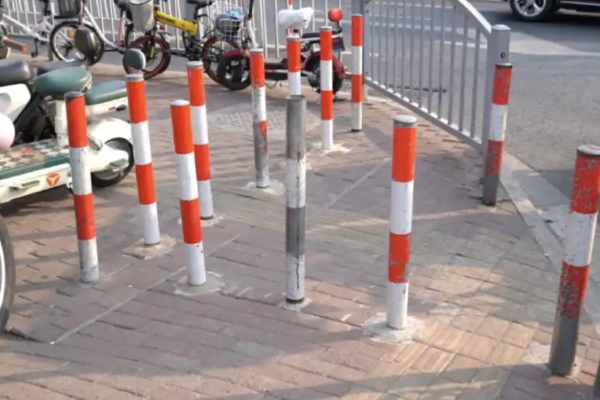Recently, 17 red and white barriers have been installed on the sidewalk at a subway station entrance in Shanghai, causing significant inconvenience to the people entering and exiting the station. Some citizens have complained that maneuvering through these barriers is like practicing “pole-walking”, with the news making it to the top of Baidu’s trending searches on April 6th.
According to a report from Kankan News on March 5th, outside Exit 4 of the Chang Jiang Nan Road subway station in Shanghai, 17 red and white barriers have been installed on the sidewalk with a spacing of less than 50 centimeters.
Chang Jiang Nan Road station is the terminus of Metro Line 18 and allows transfers to Metro Line 3, serving as a primary transportation hub for residents commuting to the surrounding communities and white-collar workers commuting to the industrial park. The area experiences heavy foot traffic and a considerable number of cyclists. In order to prevent non-motorized vehicles from occupying the sidewalk, the relevant authorities came up with this solution.
However, the narrow spacing of the barriers has made it difficult for pedestrians, especially those carrying luggage or pushing strollers. During peak travel hours, the barriers slow down pedestrian traffic, leading to congestion. Whether it’s pedestrians with free hands or those carrying luggage, pushing strollers, or holding children, passing through these 17 barriers requires them to either sway their bodies “dancing around” (risking bumping into others) or detouring onto the road.
Some citizens have complained that carrying bags could lead to collisions with others, and using wheelchairs or pushing strollers is particularly inconvenient unless strong individuals can lift them over. One citizen likened maneuvering through these barriers to practicing “pole-walking”.
While the purpose of installing the barriers was to prevent vehicles from stopping on the sidewalk, the effectiveness of this measure is not evident, as bicycles are still parked within the restricted zone. Moreover, some barriers have tightly squeezed the tactile paving on both sides.
Nearby residents express concerns, stating that placing warning barriers on the tactile paving significantly hinders the movement of visually impaired individuals. Some citizens believe that the spacing between the barriers could be wider, making it more convenient for walking during rush hours and ensuring ease of movement for those with mobility difficulties.
In response, local urban development department officials told the media that removing or adjusting the spacing of the warning barriers could exacerbate the problem of illegal bicycle parking, further inconveniencing the citizens. The best solution would be to increase parking spaces.

